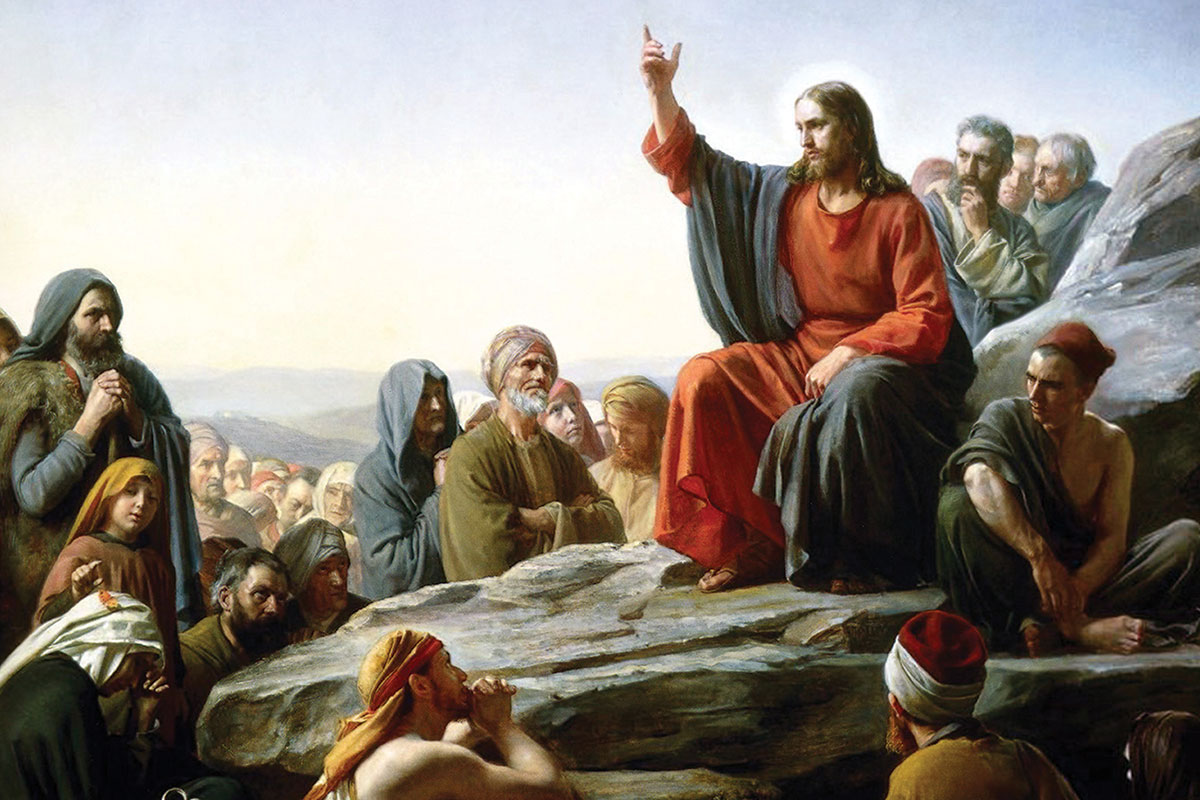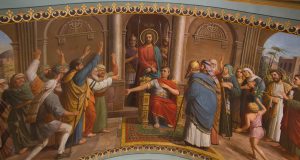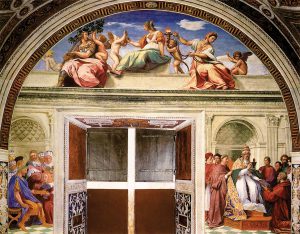
As he followed a school bus north on Interstate 29, Father Michael Griffin couldn’t help but wonder about the students inside.
He knew their high school had lost the state championship football game the night before and the bus was likely taking them home.
As he drove, Father Griffin said he started to think about the students’ emotions.
“I kind of started writing in my head,” he said. “It was about lessons to be learned and what I hoped they had taken away from their experience.”
[metaslider id=863]
Griffin, who is the pastor of St. Mary’s in Aberdeen, also serves as executive editor of the Bishop’s Bulletin. He put down his thoughts to the students on that bus and published it in his monthly column. He was proud of the column, but admitted surprise that he heard virtually nothing back from readers.
A few years later, he met some people from that small town and asked about residents’ reaction to his column.
They told him even though people may not have commented directly to him, his school bus column was “posted behind just about every cash register” on Main Street and on bulletin boards around the community.
“Sometimes you don’t hear anything and you don’t know it, but it (the writing) does touch people,” Father Griffin said.
That is the goal of the Bishop’s Bulletin which has served as the bishop’s primary communication tool with the Sioux Falls Diocese for the past 70 years.
But it is just one of a multitude of communications vehicles being used to spread the Gospel message. Today, aided by technology, Catholics can hear, read and discuss Scripture and religious topics at home, in their cars, while at work, or while exercising.
Sue Wollman was at work when she said a radio program first drew her to explore the Catholic faith.
“One day I was tired of listening to the same old songs on the radio stations and started searching around for something else,” she said.
Wollman, who was raised in the Lutheran faith, said she had tried several different churches throughout her life. When she heard a priest speaking on the Lamb Radio show she accidentally had tuned into that day, she hesitated.
“I thought, oh, he is Catholic. But my curiosity was piqued by what he was saying and I kept listening. I didn’t know Catholics believed what I believed and they had a personal relationship with Jesus. I kept listening and it is pretty much all I listen to now,” she said.
The Catholic Church encourages bishops and priests to utilize traditional, as well as newer communications methods to reach out to individuals and to share the Lord’s message.
As a follow up to the Second Vatican Council, the Pontifical Council for Social Communications issued pastoral instructions, on the importance of using all the tools available in communicating with Catholic families.
“Catholic media work is not simply one more program alongside all the rest of the Church’s activities: social communications have a role to play in every aspect of the Church’s mission,” according to the document.
Jerry Klein, delegate and director for Communications for the Diocese, said Bishop Paul Swain has the “responsibility to be the chief teacher of his diocese. As the new tools become available, there are additional ways for Bishop to communicate.”
The Bishop’s Bulletin
For Bishop Swain, The Bishop’s Bulletin is the primary conduit for communication to diocesan Catholics.
“The name itself tells you something. It is the bishop’s bulletin,” said Klein, who oversees communication endeavors for the diocese from social media and website content to radio, television and print communications.
Klein and Bishop’s Bulletin editor Gene Young are challenged with communicating the bishop’s message to a broad, diverse audience. Each month the publication reaches out to inform, educate, challenge and inspire Catholics in eastern South Dakota.
The first edition was published in January, 1947. At the time, Bishop William O. Brady wrote, “The Bishop’s Bulletin makes its bow as the official paper of the Diocese of Sioux Falls. It is planned to be the Bishop’s paper, the priest’s paper and the people’s paper – a monthly, issued to bind the people, the clergy and the Bishop more closely together in our common work.”
The publication has changed in format, method of distribution and funding mechanisms over the years, but its content has remained consistent. It includes messages from the Bishop, coverage of diocesan and parish events, celebrations of ordination and marriage anniversaries and other news and perspective from local church leaders.
Father Griffin’s column is one of the longest running features in the monthly publication. He has been writing it for 27 years, starting as a vehicle to relate his experiences as a newly ordained priest. Originally, he agreed to a six-month stint with the publication, but was asked to extend again and again and again. Today, he said the column offers “insight into a priest’s life.”
Griffin often uses South Dakota imagery and familiar sites in his storytelling to help connect with readers.
South Dakota scenes and familiar routines, he said, give readers “insights into another way of looking at the presence of God.”
“I try to start with something they can connect with,” he said. “Then it becomes spiritual. Hopefully they can see the amazing spiritual depth in their ordinary lives.”
Griffin has written on a host of subjects over the years, and finds his focus in everyday life.
“It’s always in the back of my mind that I have to write a column,” he said. “So I keep an eye out and I just notice things.”
One of his more memorable columns centered on his feelings after the death of a young firefighter in Aberdeen. He struggled with the approach he would take before deciding, “Why don’t you just write the column you want to write,” he recalled.
The difficult column helped him work through his own emotions, he said.
“At the same time, I knew I was sharing with the entire diocese.”
The Sunday TV Mass
For nearly 40 years, the Catholic Diocese of Sioux Falls has been broadcasting Sunday Mass on television. Bishop Paul Swain prays the Mass, which is shown on KELO-TV each Sunday morning.
“The bishop views it as a way to extend himself as teacher and liturgist of the diocese,” said Klein.
For those who are ill or unable to travel to Mass, the TV prayers provide support and a sense of belonging.
The Sunday Mass has become a soothing lifeline to young Brayden Schlader, according to his mother, Terri. Brayden, who has Downs Syndrome and struggles with seizures, respiratory and other medical problems, is drawn to the broadcast every Sunday morning.
“When we started TV Mass, Brayden was immediately spellbound by it,” she said. “He loves watching Bishop Swain and listening to his sermons.”
Her son Brayden has been hospitalized five times this year. But, even in the face of his medical struggles, Brayden finds extraordinary peace watching the Sunday Mass.
“I think TV Mass resonates so much with Brayden, because he can see it at home. He is calmed by Bishop Swain’s voice and demeanor,” Terri Schlader said.
“We watch it every Sunday morning. … We even watch it when he is in the hospital,” she said.
On a recent Sunday, Brayden was attending his brother Brenden’s Confirmation at Holy Trinity in Huron.
When Brayden heard Bishop Swain’s voice from the altar in church, his mother said, he got very excited. “He recognized him immediately,” she said.
He was able to meet the bishop at the reception following the Mass, an experience he won’t forget, according to his mother.
“Meeting Bishop Swain made Brayden’s year. He is very, very happy when we talk about it.”
Originally, the TV Mass was a half-hour broadcast, recorded in the studio of a local television station. Then, for a time, it moved to the chapel of what is now O’Gorman Junior High School, then back to a TV studio, and then to the Chapel of the Sacred Heart at the Cathedral.
For the past several years, the TV Mass has been recorded at the Cathedral 4 p.m. Saturday Mass.
Bishop Swain wanted the TV Mass moved into the main Cathedral, after its historic restoration was completed. Klein said the Bishop wanted viewers to be able to experience the Mass with the backdrop that can uplift and teach.
“He wanted to use it – the beauty and art of the Cathedral to help share that (with the Diocese),” said Klein.
Father James Morgan, pastor of the Cathedral of Saint Joseph, said the TV Mass helps connect the people of the diocese to the Mother Church.
The Cathedral backdrop, he said, hopes to accomplish two things:
“Increase an awareness throughout the diocese that as Catholics we are “Church Universal,” and “collapse the distances – physical and psychological – that keep us from having a united vision and participation in helping to bring about the Kingdom here on earth.”
Klein said diocesan officials know that the TV Mass is reaching Catholics and others.
“People are faithful to it and regularly donate” he said. “For some people, that’s their parish and it’s important to them.”
Videos of the Mass are archived and available on the diocesan website.
Catholic Views
The Sioux Falls diocese also uses the radio in its outreach to believers.
The program, “Catholic Views,” was started and originally hosted by Monsignor Louis Delahoyde more than 50 years ago. It continues today as an important weekly touchstone for Catholics.
The show, which airs on Sunday mornings on commercial stations in Sioux Falls, Aberdeen and Milbank, and on the Catholic radio network, features the Sunday Mass readings, short news items that pertain to Catholics, and an in-person interview with a guest. Topics have ranged from discussions on upcoming events and interviews with leaders of various local ministries to discussions with representatives of Catholic Relief Services, who update international projects.
Klein has hosted “Catholic Views” since 1994.
The shows also are archived on the diocesan website.
Local parishes also utilize radio programming.
In some communities, “Radio Rosary” programs air; in others a weekly Mass is broadcast on the local radio station.
Catholics have a variety of other radio and television programming available beyond what the diocese produces.
Lamb Radio, is a non-profit Catholic network broadcasting in eastern South Dakota. It features live programs, talk shows on social and community issues and other interactive Catholic programming. (Lambradio.com, 104.3 Sioux Falls, 91.3 Hartford, Mitchell, Yankton, and 88.9 Aberdeen area)
The station is affiliated with EWTN, Eternal Word Television Network, which broadcasts Catholic programming on radio and television around the world.
Wollman credits Lamb and EWTN for leading her to take steps to join the Catholic Church.
“The radio messages that I hear touch my heart. They open up the Bible and bring it alive for me. Passages that I was confused about, now they make sense,” she said.
Diocesan website
The diocesan website provides information and connects Catholics with religious programs, ministries and resources.
“It has become a key hub for our communications,” said Klein.
The diocesan communications office uses social media and other avenues to drive people to the website where they can find information such as details on events, contacts for various diocesan ministries and a directory of priests and deacons.
The Bishop’s TV Mass homilies also are posted, as are radio broadcasts and the stories from the most recent Bishop’s Bulletin. Links to YouTube and other social media are also found there.
While technology has opened up new channels for communication, it also can complicate things, Klein said. Religious views shared across the internet, for instance, can be divisive and confusing. With a vast array of religious programming and content available online, Catholics sometimes are unsure where to turn.
Klein said the diocese and websites of other known trustworthy sources such as EWTN and Catholic News Service, and the Vatican itself are good places to start. (vatican.va)
“You have to be discerning as a consumer,” he said. “It’s no different for Catholics.”
Technology in the parish
A variety of communication tools are put to use by individual parish pastors, as well.
At the Cathedral, Morgan said technology plays a key role in ministries and outreach..
“We use email lists, social media and our website,” he said providing links to important Cathedral-related programs, such as the Catholic Men’s Business Fraternity.
“When using social media, we take into consideration demographics and different audiences, for sure, depending upon the intent of our message,” he said.
Communicating is important because parishioners look to the pastor for leadership, Morgan said.
“How do the sheep recognize the Shepherd? Through His voice. Likewise, the parish family yearns for leadership from their pastor. The only means by which to achieve this is through the voice of the pastor,” said Father Morgan.
“He must be constantly presenting his vision, his thoughts, his ideas so that the parish family can contribute to this vision and feel a part of it and not removed from it.”
There are a variety of other digital programs for Catholics to utilize for adult education, young adult formation and RCIA. Video resources such as “Word on Fire,” by Bishop Robert Barron, are used in parish group discussions.
At Cathedral, priests use the marriage preparatory video series on the Diocesan website for independent and assigned work with couples. Parishioners also can go online and independently download material for catechetical growth and formation, Morgan said.
Some priests post their homilies online, others have experimented with short videos to share lessons and reflections.
All of it is designed to spread the gospel message.
“It’s all about how do we help people know about and love Jesus Christ?” said Klein.
For Wollman, introduction to church teaching through radio and television programs have led her to a deep commitment to the Catholic faith.
“It is the faith for me,” she said. “In all the years of searching, this is where I am to be. I am home.”


